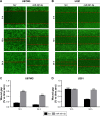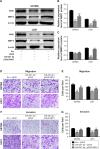miR-361-5p inhibits glioma migration and invasion by targeting SND1
- PMID: 30214229
- PMCID: PMC6118279
- DOI: 10.2147/OTT.S171539
miR-361-5p inhibits glioma migration and invasion by targeting SND1
Abstract
Background: Downregulation of miR-361-5p contributes to epithelial-mesenchymal transition of glioma cells. However, the relevance of miR-361-5p to migration and invasion of gliomas remains unknown.
Materials and methods: The relationship between miR-361-5p and SND1 expression was analyzed in 120 human gliomas and 8 glioma cell lines by in situ hybridization, immunohistochemistry, and Western blot. Dual-luciferase reporter assay was used to identify SND1 as a target of miR-361-5p. The mechanisms through which miR-361-5p inhibits glioma cell migration and invasion were studied by in vitro assays.
Results: miR-361-5p expression was significantly downregulated in glioma tissues and glioma cell lines, and was inversely correlated with glioma grades. However, SND1 expression was positively correlated with glioma grades and inversely correlated with miR-361-5p expression. miR-361-5p overexpression suppressed glioma cell migration and invasion through targeting SND1 and subsequently decreasing MMP-2 expression. In glioma cell lines, SND1 overexpression could partly reverse the antitumor effects of miR-361-5p.
Conclusion: The findings provide evidence that miR-361-5p directly targets SND1 to degradation and then reduces MMP-2 gene transcription, thus inhibiting glioma migration and invasion. miR-361-5p is an important tumor suppressor and a novel diagnostic biomarker of glioma, and miR-361-5p and SND1 are potential therapeutic candidates for malignant gliomas.
Keywords: SND1; glioma; invasion; miR-361-5p; migration.
Conflict of interest statement
Disclosure The authors report no conflicts of interest in this work.
Figures








Similar articles
-
miR-320a functions as a suppressor for gliomas by targeting SND1 and β-catenin, and predicts the prognosis of patients.Oncotarget. 2017 Mar 21;8(12):19723-19737. doi: 10.18632/oncotarget.14975. Oncotarget. 2017. PMID: 28160566 Free PMC article.
-
miRNA-296-5p functions as a potential tumor suppressor in human osteosarcoma by targeting SND1.Chin Med J (Engl). 2021 Feb 9;134(5):564-572. doi: 10.1097/CM9.0000000000001400. Chin Med J (Engl). 2021. PMID: 33652459 Free PMC article.
-
miR-1224-5p inhibits the proliferation and invasion of ovarian cancer via targeting SND1.Hum Cell. 2020 Jul;33(3):780-789. doi: 10.1007/s13577-020-00364-4. Epub 2020 May 14. Hum Cell. 2020. PMID: 32409958
-
Suppression of miR-184 in malignant gliomas upregulates SND1 and promotes tumor aggressiveness.Neuro Oncol. 2015 Mar;17(3):419-29. doi: 10.1093/neuonc/nou220. Epub 2014 Sep 12. Neuro Oncol. 2015. PMID: 25216670 Free PMC article.
-
MicroRNA-361-5p inhibits epithelial-to-mesenchymal transition of glioma cells through targeting Twist1.Oncol Rep. 2017 Mar;37(3):1849-1856. doi: 10.3892/or.2017.5406. Epub 2017 Jan 25. Oncol Rep. 2017. PMID: 28184914
Cited by
-
The novel chromatin architectural regulator SND1 promotes glioma proliferation and invasion and predicts the prognosis of patients.Neuro Oncol. 2019 Jun 10;21(6):742-754. doi: 10.1093/neuonc/noz038. Neuro Oncol. 2019. PMID: 30753603 Free PMC article.
-
Inhibitory effects of miRNAs in astrocytes on C6 glioma progression via connexin 43.Mol Cell Biochem. 2021 Jul;476(7):2623-2632. doi: 10.1007/s11010-021-04118-0. Epub 2021 Mar 3. Mol Cell Biochem. 2021. PMID: 33660186
-
The Oncogene PIM1 Contributes to Cellular Senescence by Phosphorylating Staphylococcal Nuclease Domain-Containing Protein 1 (SND1).Med Sci Monit. 2019 Nov 17;25:8651-8659. doi: 10.12659/MSM.917867. Med Sci Monit. 2019. PMID: 31860636 Free PMC article.
-
MicroRNA-361: A Multifaceted Player Regulating Tumor Aggressiveness and Tumor Microenvironment Formation.Cancers (Basel). 2019 Aug 7;11(8):1130. doi: 10.3390/cancers11081130. Cancers (Basel). 2019. PMID: 31394811 Free PMC article. Review.
-
The Multifunctional Protein Syntenin-1: Regulator of Exosome Biogenesis, Cellular Function, and Tumor Progression.Int J Mol Sci. 2023 May 29;24(11):9418. doi: 10.3390/ijms24119418. Int J Mol Sci. 2023. PMID: 37298370 Free PMC article. Review.
References
-
- Wen PY, Kesari S. Malignant gliomas in adults. N Engl J Med. 2008;359(5):492–507. - PubMed
-
- Clarke J, Butowski N, Chang S. Recent advances in therapy for glioblastoma. Arch Neurol. 2010;67(3):279–283. - PubMed
-
- Galasso M, Sandhu SK, Volinia S. MicroRNA expression signatures in solid malignancies. Cancer J. 2012;18(3):238–243. - PubMed
LinkOut - more resources
Full Text Sources
Other Literature Sources
Miscellaneous

